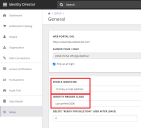Configure the general behavior of the Web Portal
In the Management Portal at Setup > General (in the Behavior section), configure the general behavior of the Web Portal.
Configuration
|
Field |
Explanation and Tips |
|---|---|
|
Specify one or more URLs to the Web Portal. Multiple URLs can be useful if you want to provide several Web Portals with a different look and feel. You can also use multiple URLs for a multi-tenant environment.
|
|
|
Guided Tour / Help |
Specify the URL to the guided tour in the Web Portal. A default document is available that provides users with information and tips about the functionality of the Web Portal. You can also make a custom document available for this purpose.
|
|
People Identifier |
Specify the identifier for user authentication.
|
|
Identity Broker Claim |
Map the specified people identifier to an Identity Broker claim. In Identity Director environments that use Identity Broker authentication, this allows the Identity Broker to authenticate people in your Identity Director environment, by matching the claim with a valid people identifier value. This provides a seamless sign in experience to your end users by allowing them to sign in with a custom identifier (e.g. UPN).
See Getting Started with the Identity Broker for further information on installation and configuration of the Identity Broker. |
|
Delete "Ready for deletion" user after (days) |
As soon as a user has been Marked for Deletion, the Transaction Engine starts returning all services to which the user had subscribed. When this process completes, the user is Ready for Deletion. From this state, users can no longer log in to Identity Director, nor do they require any licenses.
|
|
Delete Finished Transactions After (Days) |
Transactions that have finished (Completed, Aborted, or Failed), are removed from the transaction history after the specified number of days. Transactions that are Pending or On Hold are not affected. Transactions are deleted in batches of 1000. Each deleted batch is logged in the Audit Trail. |
|
Web Portal Service Request |
Specify the default behavior of service labels in the Web Portal. You can override this behavior for each individual service in its delivery trigger.
|
|
Service Rating |
Specify the default rating behavior for services. Service rating allows users to provide feedback to the IT staff and to other users about their experience.
Users can rate services by giving a star rating between 1 and 5.
|
|
Workflow Detail |
Specify the detail level in the Requests page of the Web Portal when people track the status of a service. This allows you to show additional information for the actions: Approve Transaction, Confirm Transaction, Invoke Run Book, Perform Tasks, Postpone Transaction and Provide Information.
|
|
Delivery Time |
Specify the default value for showing the average delivery time for services. This allows users to find out how long it usually takes to receive a service. You can select different time spans:
|
|
Web Portal Sorting |
Specify the default value for the sorting view in the Web Portal.
|
|
Delegation |
Specify if users in the Web Portal are allowed to delegate tasks that require user input to someone else. This is useful if users are unable to take action, for example because they are absent from work or otherwise unavailable. If they delegate tasks to another user, service transactions can still be completed. If you enable the delegation functionality, the profile page of each user in the Web Portal contains delegation settings. This allows each individual user to decide whether to actually use delegation. And if so, whom to delegate tasks to and during which time-frame (if any).
|
|
Workflow State Name |
At the bottom of the General page, you can add custom Workflow State Names that you can then use as an End state in your workflows to provide more context for the success or failure of an instance of a workflow.
On the Transactions page, custom state names are displayed and can be selected using a Filter ( |
